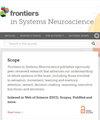Pointing in cervical dystonia patients
IF 3.5
4区 医学
Q2 NEUROSCIENCES
引用次数: 0
Abstract
IntroductionThe normal hemispheric balance can be altered by the asymmetric sensorimotor signal elicited by Cervical Dystonia (CD), leading to motor and cognitive deficits.MethodsDirectional errors, peak velocities, movement and reaction times of pointing towards out-of-reach targets in the horizontal plane were analysed in 18 CD patients and in 11 aged-matched healthy controls.ResultsCD patients displayed a larger scatter of individual trials around the average pointing direction (variable error) than normal subjects, whatever the arm used, and the target pointed. When pointing in the left hemispace, all subjects showed a left deviation (constant error) with respect to the target position, which was significantly larger in CD patients than controls, whatever the direction of the abnormal neck torsion could be. Reaction times were larger and peak velocities lower in CD patients than controls.DiscussionDeficits in the pointing precision of CD patients may arise from a disruption of motor commands related to the sensorimotor imbalance, from a subtle increase in shoulder rigidity or from a reduced agonists activation. Their larger left bias in pointing to left targets could be due to an increased right parietal dominance, independently upon the direction of head roll/jaw rotation which expands the left space representation and/or increases left spatial attention. These deficits may potentially extend to tracking and gazing objects in the left hemispace, leading to reduced skills in spatial-dependent motor and cognitive performance.指颈肌张力障碍患者
颈肌张力障碍(CD)引起的不对称感觉运动信号可改变正常的半球平衡,导致运动和认知障碍。方法分析18例CD患者和11例年龄匹配的健康对照者在水平面上指向不可及目标的方向误差、峰值速度、运动和反应时间。结果与正常受试者相比,scd患者在平均指向方向(可变误差)周围显示出更大的个体试验散点,无论使用何种手臂,目标指向。当指向左半球时,所有受试者都表现出相对于目标位置的左偏差(恒定误差),无论异常颈部扭转的方向如何,CD患者的左偏差都明显大于对照组。与对照组相比,乳糜泻患者的反应时间更长,峰值速度更低。乳糜泻患者的指向精度缺陷可能是由于与感觉运动不平衡相关的运动指令中断、肩部僵硬的轻微增加或激动剂激活的减少而引起的。他们在指向左侧目标时更大的左侧偏倚可能是由于右顶叶优势的增加,而与头滚动/下巴旋转的方向无关,这扩大了左侧空间表征和/或增加了左侧空间注意力。这些缺陷可能会延伸到左脑跟踪和凝视物体,导致空间依赖运动和认知能力下降。
本文章由计算机程序翻译,如有差异,请以英文原文为准。
求助全文
约1分钟内获得全文
求助全文
来源期刊

Frontiers in Systems Neuroscience
Neuroscience-Developmental Neuroscience
CiteScore
6.00
自引率
3.30%
发文量
144
审稿时长
14 weeks
期刊介绍:
Frontiers in Systems Neuroscience publishes rigorously peer-reviewed research that advances our understanding of whole systems of the brain, including those involved in sensation, movement, learning and memory, attention, reward, decision-making, reasoning, executive functions, and emotions.
 求助内容:
求助内容: 应助结果提醒方式:
应助结果提醒方式:


